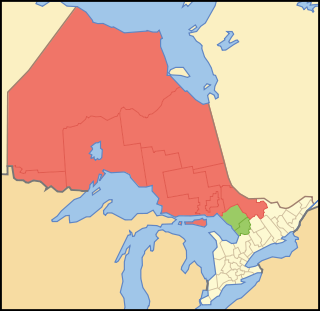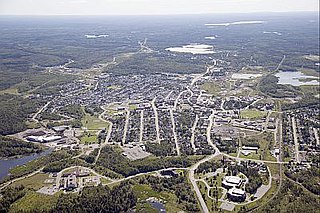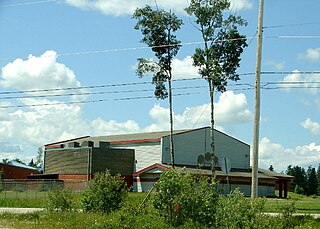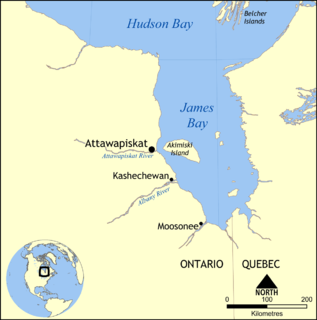
James Bay is a large body of water located on the southern end of Hudson Bay in Canada. Both bodies of water extend from the Arctic Ocean, of which James Bay is the southernmost part. It borders the Canadian provinces of Quebec and Ontario. Islands within the bay, the largest of which is Akimiski Island, are part of Nunavut.

Northern Ontario is a primary geographic and quasi-administrative region of the Canadian province of Ontario, the other primary region being Southern Ontario. Most of the core geographic region is located on part of the Superior Geological Province of the Canadian Shield, a vast rocky plateau located mainly north of Lake Huron, the French River, Lake Nipissing, and the Mattawa River. The statistical region extends south of the Mattawa River to include all of the District of Nipissing. The southern section of this district lies on part of the Grenville Geological Province of the Shield which occupies the transitional area between Northern and Southern Ontario. The extended federal and provincial quasi-administrative regions of Northern Ontario have their own boundaries even further south in the transitional area that vary according to their respective government policies and requirements. Ontario government departments and agencies such as the Growth Plan for Northern Ontario and the Northern Ontario Heritage Fund Corporation define Northern Ontario as all areas north of, and including, the districts of Parry Sound and Nipissing for political purposes, whilst the federal government, but not the provincial, also includes the district of Muskoka.

Kirkland Lake is a town and municipality in Timiskaming District in Northeastern Ontario, Canada. The 2016 population, according to Statistics Canada, was 7,981.

Cobalt is a town in Timiskaming District, Ontario, Canada. It had a population of 1,118 at the 2016 Census.

Kenora District is a district and census division in Northwestern Ontario, Canada. The district seat is the City of Kenora.

Pickle Lake is a township in the Canadian province of Ontario, and is the most northerly community in the province that has year-round access by road. Located 530 kilometres (330 mi) north of Thunder Bay, highway access is via Highway 599, the only access road to the town from the south. More northerly communities rely on winter roads for access and are cut off to land travel in the summer. Highway 599 meets the Northern Ontario Resource Trail, formerly Tertiary Highway 808, at Pickle Lake.

Neskantaga First Nation is a remote Oji-Cree First Nation band government in the northern reaches of the Canadian province of Ontario, situated along the shore of Attawapiskat Lake in the District of Kenora.

Eabametoong, also known as Fort Hope or Eabamet Lake by Canada Post, is an Ojibwe First Nations band government in Kenora District, Ontario, Canada. Located on the shore of Eabamet Lake in the Albany River system, the community is located approximately 300 km (190 mi) northeast of Thunder Bay and is accessible only by airplane via Fort Hope Airport or water, or by winter/ice roads, which connect the community to the Northern Ontario Resource Trail. The Eabametoong First Nation Reserve is completely surrounded by territory of the Unorganized Kenora District.
Secondary Highway 599, commonly referred to as Highway 599, is a provincially maintained secondary highway in the Canadian province of Ontario. The 291.0 km (180.8 mi) route connects Highway 17 near Ignace with the remote northern community of Pickle Lake; its terminus at Pickle Lake marks the northernmost point on the provincial highway system. Highway 599 was first assigned in 1956 between Savant Lake and Pickle Lake, although it did not connect with the rest of the provincial highway system at the time. Construction to link it with Highway 17 in Ignace took place between 1958 and 1966. The northern end of Highway 599 is one of two possible starting points for a road to the Ring of Fire mineral deposits, the other being Highway 584 in Nakina.

Webequie First Nation is located on the northern peninsula of Eastwood Island on Winisk Lake, 540 km (336 mi) north of Thunder Bay in Ontario, Canada. Webequie is a fly-in community with no summer road access. The primary way into the community is by air to Webequie Airport or winter road, which connects to the Northern Ontario Resource Trail. The First Nation have the 34,279 ha Webequie Indian Reserve. The Webequie or Webiqui Indian Settlement also have reserve status. Webequie First Nation is a member of the Matawa First Nations, a Regional Chiefs' Council and a member of the Nishnawbe Aski Nation.

Nibinamik First Nation, also known as Summer Beaver Band, is a small Oji-Cree First Nation reserve in Northern Ontario, located on the Summer Beaver Settlement that is connected to the rest of the province by its airport, and a winter/ice road that leads to the Northern Ontario Resource Trail.

Constance Lake First Nation is an Oji-Cree First Nations band government located on the shores of Constance Lake near Hearst, Cochrane District in northeastern Ontario, Canada. It is directly north of the community of Calstock along a continuation of Ontario Highway 663. Constance Lake First Nation is home to close to 1605 members of Cree and Ojibway ancestry with approximately 820 living on reserve. It may also be known as "Home of Sonny Sutherland". The reserves, Constance Lake 92 and English River 66, total 7,686 acres (3,110 ha) in size.

The Attawapiskat River is a river in Kenora District in northwestern Ontario, Canada, that flows east from Attawapiskat Lake to James Bay.
The Ring of Fire is the name given to a massive planned chromite mining and smelting development project in the mineral-rich James Bay Lowlands of Northern Ontario. The Ring of Fire development would impact nine First Nations, and potential developers are required to negotiate an Impact Benefit Agreement with these communities prior to development. The region is centred on McFaulds Lake, near the Attawapiskat River in Kenora District, approximately 400 kilometres (250 mi) northeast of Thunder Bay, about 70 kilometres (43 mi) east of Webequie, and due north of Marten Falls and Ogoki Post, which is near/on the west of James Bay.
The Canadian Malartic Corporation is a mining company that operates the Malartic mine near Malartic, Quebec. Prior to 2014 the company was a public company named Osisko Mining Corporation with shares listed on the Toronto Stock Exchange and New York Stock Exchange. In 2014, Osisko Mining was subject to a hostile takeover bid by Goldcorp but an alternative bid by white knights Yamana Gold and Agnico Eagle Mines Limited was accepted that, in addition to offering a higher price, created the spin-off Osisko Gold Royalties and turned Osisko Mining Corporation into the subsidiary company Canadian Malartic Corporation jointly owned by Yamana Gold and Agnico Eagle. From its founding in 1982 until 2006, Osisko Mining bought and sold mineral exploration rights in Quebec, conducting exploration work. The company acquired an interest in the Canadian Malartic property in 2004 and after promising feasibility studies the mine was constructed with commercial production achieved in May 2011.is a Canadian company engaged in the exploration and development of several mineral properties in Quebec.

The Abitibi gold belt is a region of Canada that extends from Wawa, Ontario to Val-d'Or, Quebec. Located within the mineral-rich Abitibi greenstone belt, the gold belt is an established gold mining district having produced over 100 mines, and 170 million ounces of gold since 1901. Timmins, a town founded in 1912 following the Porcupine Gold Rush and subsequent creation of the Hollinger, MacIntyre and Big Dome Mines, is one area in the region that experienced a gold rush beginning in 1909. The Kerr Addison Mine in Virginiatown was at one time Canada's largest gold producing mine. Many of the towns readily acknowledge gold mining as part of their history, some being named after gold. One of Canada's 'large roadside attractions' is a 12-foot replica of a 1908 gold sovereign built to commemorate Canada's first gold coin which was made using gold from the Kerr Addison mine.

Big Dan Mine is an abandoned underground mine in Northeastern Ontario, Canada. It is located about 1 km (0.62 mi) southwest of Net Lake and just west of the Ontario Northland Railway in east-central Strathy Township. It is named after Dan O'Connor, who first claimed the site in the 1890s.
KWG Resources Inc. is a Toronto, Ontario-based publicly traded junior Canadian mining company, most recently notable for its association with the development of chromite deposits in the mineral rich but largely inaccessible Ring of Fire in the James Bay lowlands of Northern Ontario. By 2013, KWG's wholly owned subsidiary, Canada Chrome Corporation, had "staked" a 330 km (210 mi)-long "string of mining claims" in anticipation of the construction of a transportation corridor that they hoped would link the stranded assets of the remote Big Daddy chromite deposit to CN Rail (CN) near Nakina, Ontario.
The Road to Webequie is a Canadian short documentary film, directed by Tess Girard and Ryan Noth and released in 2016. The film profiles the Webequie First Nation, a remote Nishnawbe Aski community in Northern Ontario, and the potential impacts both positive and negative of the Ontario provincial government's plan to build the community's first all-weather road access as part of the Northern Ontario Ring of Fire mining development.

The geology of Ontario consists of the study of the rock formations in the most populated province of Canada. Ontario has some of the oldest rocks on Earth. It is made up of ancient Precambrian igneous and metamorphic rock and overlain by younger sedimentary rocks and soils.












